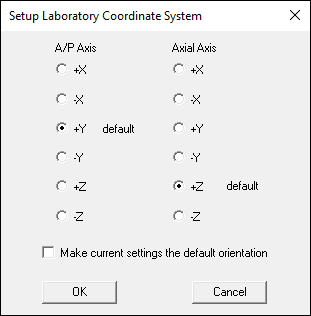Laboratory Coordinate System
| Language: | English • français • italiano • português • español |
|---|
There is no standard coordinate system used in the motion analysis community (despite the efforts of the International Society of Biomechanics). We assume that each individual user, however, has a standard coordinate system for their laboratory. The coordinate system identified in this dialog is saved to the user's registry and will be in effect until changed explicitly by this program or if the registry entries are deleted.
The axes of the global Visual3D Coordinate System (V3CS) are oriented such that the V3CS Z axis points vertically upward, the V3CS Y axis points along the direction of progression and the V3CS X axis is perpendicular to the other two axes as described by a right-handed Cartesian coordinate system. If the user employs a Laboratory Coordinate System (LCS) with an orientation that differs from that assumed by Visual3D then the dialog box shown above must be modified.
The user can modify the coordinate system defined for the laboratory by selecting the "Modify Lab Coordinate System" option in the "Properties" menu. The axial direction is assumed to represent the vertical direction and the gravity unit vector is modified accordingly.
For example,
If the axial direction is +z then the gravity unit vector is {0, 0, -1};
If the axial direction is +y then the gravity unit vector is {0, -1, 0};
If the axial direction is +x then the gravity unit vector is {-1, 0, 0}.
Setting the Laboratory Coordinate System (LCS) in Visual3D has many consequences. First, the LCS defines the coordinate system in which the Motion Capture data was recorded. Second, the LCS defines the direction of gravity. Third, the LCS defines the default Segment Coordinate System when a segment is created in Model Builder.
BEWARE
If the user changes the laboratory coordinate system in the Workspace after one or more segments have been created, the segments created after the change will have a different segment coordinate system for those created before the change.
Modifying the Laboratory Coordinate System

The user can modify the coordinate system defined for the laboratory by selecting the "Modify Lab Coordinate System" option in the "Properties" menu. The axial direction is assumed to represent the vertical direction and the gravity unit vector is modified accordingly. For example,
if the axial direction is +z then the gravity unit vector is {0, 0, -1};
If the axial direction is +y then the gravity unit vector is {0, -1, 0};
If the axial direction is +x then the gravity unit vector is {-1, 0, 0}.
